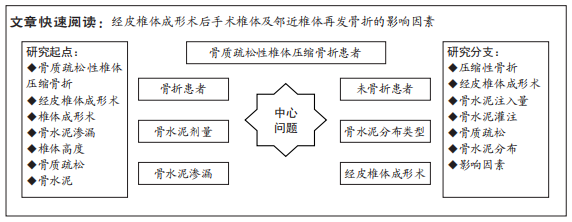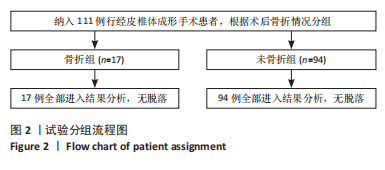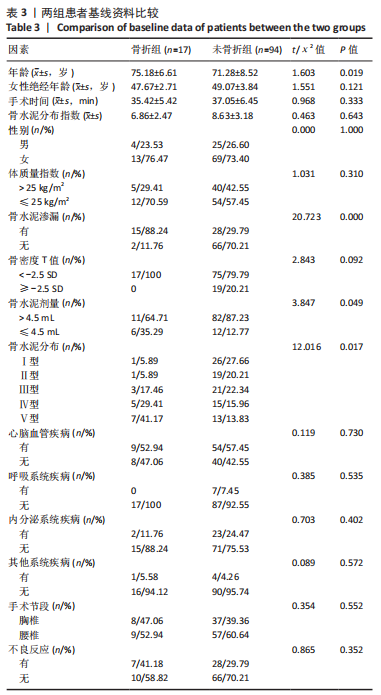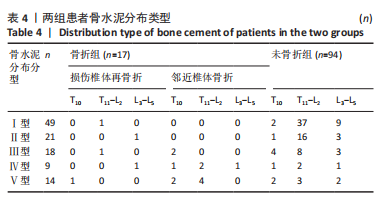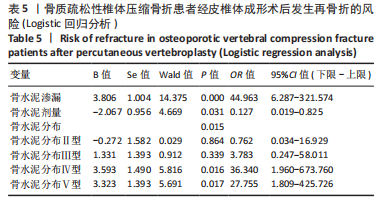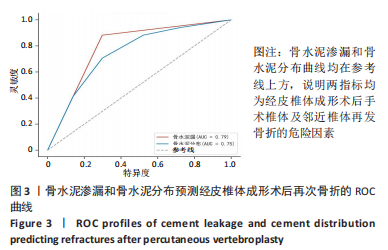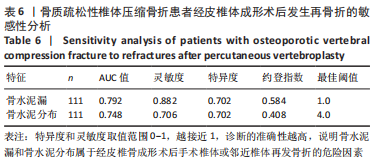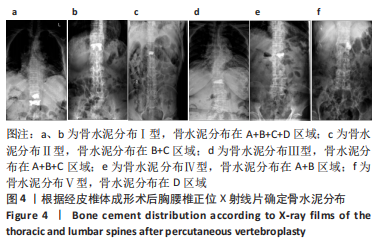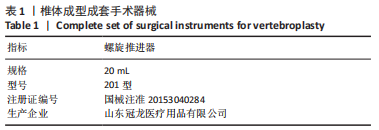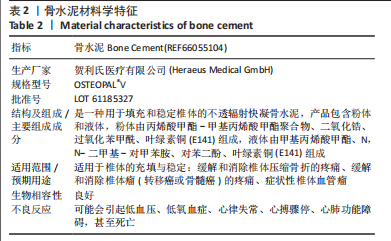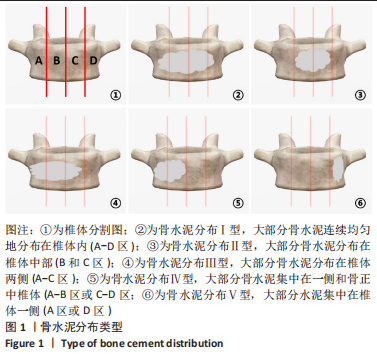[1] LIANG L, CHEN X, JIANG W, et al. Balloon kyphoplasty or percutaneous vertebroplasty for osteoporotic vertebral compression fracture? An updated systematic review and meta-analysis. Ann Saudi Med. 2016;36(3):165-174.
[2] PARREIRA PCS, MAHER CG, MEGALE RZ, et al. An overview of clinical guidelines for the management of vertebral compression fracture: a systematic review. Spine J. 2017;17(12):1932-1938.
[3] LIN J, QIAN L, JIANG C, et al. Bone cement distribution is a potential predictor to the reconstructive effects of unilateral percutaneous kyphoplasty in OVCFs: a retrospective study. J Orthop Surg Res. 2018;13(1):140.
[4] ZHOU C, HUANG S, LIAO Y, et al. Correlation analysis of larger side bone cement volume/vertebral body volume ratio with adjacent vertebral compression fractures during vertebroplasty. Front Endocrinol (Lausanne). 2023;14:1072087.
[5] SANLI I, VAN KUIJK SMJ, DE BIE RA, et al. Percutaneous cement augmentation in the treatment of osteoporotic vertebral fractures (OVFs) in the elderly: a systematic review. Eur Spine J. 2020;29(7):1553-1572.
[6] 孙育良,熊小明,何本祥,等.椎体成形骨填充材料的研究与现状[J].中国组织工程研究,2017,21(14):2285-2290.
[7] LI X, LU Y, LIN X. Refracture of osteoporotic vertebral body after treatment by balloon kyphoplasty: Three cases report. Medicine (Baltimore). 2017; 96(49):e8961.
[8] 沈松,徐彬.经皮椎体成形骨水泥呈弥散型分布可减少邻近椎体再骨折的发生率[J].中国组织工程研究,2022,26(4):499-503.
[9] CLARK W, BIRD P, GONSKI P, et al. Safety and efficacy of vertebroplasty for acute painful osteoporotic fractures (VAPOUR): a multicentre, randomised, double-blind, placebo-controlled trial. Lancet. 2016;388(10052):1408-1416.
[10] WANG Y, LIU B, SUN Z, et al. Comparative Efficacy of Three Minimally Invasive Procedures for Kümmell’s Disease: A Systematic Review and Network Meta-Analysis. Front Surg. 2022;9:893404.
[11] LV B, JI P, FAN X, et al. Clinical Efficacy of Different Bone Cement Distribution Patterns in Percutaneous Kyphoplasty: A Retrospective Study. Pain Physician. 2020;23(4):E409-e416.
[12] LI Q, LONG X, WANG Y, et al. Clinical observation of two bone cement distribution modes after percutaneous vertebroplasty for osteoporotic vertebral compression fractures. BMC Musculoskelet Disord. 2021;22(1): 577.
[13] LI K, JI C, LUO D, et al. Role of percutaneous vertebroplasty with high-viscosity cement in the treatment of severe osteoporotic vertebral compression fractures. Sci Rep. 2021;11(1):4602.
[14] GAUGHEN JR JR, JENSEN ME, SCHWEICKERT PA, et al. The therapeutic benefit of repeat percutaneous vertebroplasty at previously treated vertebral levels. AJNR Am J Neuroradiol. 2002;23(10):1657-1661.
[15] ZHANG L, WANG Q, WANG L, et al. Bone cement distribution in the vertebral body affects chances of recompression after percutaneous vertebroplasty treatment in elderly patients with osteoporotic vertebral compression fractures. Clin Interv Aging. 2017;12:431-436.
[16] RHO YJ, CHOE WJ, CHUN YI. Risk factors predicting the new symptomatic vertebral compression fractures after percutaneous vertebroplasty or kyphoplasty. Eur Spine J. 2012;21(5):905-911.
[17] KOMEMUSHI A, TANIGAWA N, KARIYA S, et al. Percutaneous vertebroplasty for osteoporotic compression fracture: multivariate study of predictors of new vertebral body fracture. Cardiovasc Intervent Radiol. 2006;29(4):580-585.
[18] MARTIKOS K, GREGGI T, FALDINI C, et al. Osteoporotic thoracolumbar compression fractures: long-term retrospective comparison between vertebroplasty and conservative treatment. Eur Spine J. 2018;27(Suppl 2): 244-247.
[19] BAEK S W, KIM C, CHANG H. The relationship between the spinopelvic balance and the incidence of adjacent vertebral fractures following percutaneous vertebroplasty. Osteoporos Int. 2015;26(5):1507-1513.
[20] NING L, WAN S, LIU C, et al. New Levels of Vertebral Compression Fractures after Percutaneous Kyphoplasty: Retrospective Analysis of Styles and Risk Factors. Pain Physician. 2015;18(6):565-572.
[21] YI X, LU H, TIAN F, et al. Recompression in new levels after percutaneous vertebroplasty and kyphoplasty compared with conservative treatment. Arch Orthop Trauma Surg. 2014;134(1):21-30.
[22] YANG W, YANG J, LIANG M. Percutaneous Vertebroplasty Does Not Increase the Incidence of New Fractures in Adjacent and Nonadjacent Vertebral Bodies. Clin Spine Surg. 2019;32(2):E99-e106.
[23] KLAZEN CA, VENMANS A, DE VRIES J, et al. Percutaneous vertebroplasty is not a risk factor for new osteoporotic compression fractures: results from VERTOS II. AJNR Am J Neuroradiol. 2010;31(8):1447-1450.
[24] CHEVALIER Y, PAHR D, CHARLEBOIS M, et al. Cement distribution, volume, and compliance in vertebroplasty: some answers from an anatomy-based nonlinear finite element study. Spine (Phila Pa 1976). 2008;33(16):1722-1730.
[25] CHEN B, LI Y, XIE D, et al. Comparison of unipedicular and bipedicular kyphoplasty on the stiffness and biomechanical balance of compression fractured vertebrae. Eur Spine J. 2011;20(8):1272-1280.
[26] 刘群,孙东东,高丽兰,等.经皮椎体后凸成形后再发骨折相关因素的Meta分析[J].中国组织工程研究,2020,24(6):976-984.
[27] LIANG X, ZHONG W, LUO X, et al. Risk factors of adjacent segmental fractures when percutaneous vertebroplasty is performed for the treatment of osteoporotic thoracolumbar fractures. Sci Rep. 2020;10(1):399.
[28] ZHANG Z, FAN J, DING Q, et al. Risk factors for new osteoporotic vertebral compression fractures after vertebroplasty: a systematic review and meta-analysis. J Spinal Disord Tech. 2013;26(4):E150-157.
[29] 吕文,刘艺明,陈光,等.经横突根部单侧穿刺的改良PVP与PCVP技术治疗腰椎骨质疏松性骨折的疗效对比[J].颈腰痛杂志,2020,41(2):154-157.
[30] 崔志远,毛兆虎,刘玉林,等.单侧PVP术对OVCF术后椎体高度恢复及疼痛程度的效果研究[J].中国医药导报,2021,18(18):92-95.
[31] 罗伟斌,林勇,孙春喜,等.经皮椎体成形术术后新发椎体骨折特点及危险因素分析[J].中国医药科学,2021,11(10):210-212,224.
[32] WANG D, LI Y, YIN H, et al. Three-dimensional finite element analysis of optimal distribution model of vertebroplasty. Ann Palliat Med. 2020;9(3): 1062-1072.
[33] GOLDSTEIN CL, CHUTKAN NB, CHOMA TJ, et al. Management of the Elderly With Vertebral Compression Fractures. Neurosurgery. 2015;77 Suppl 4:S33-45.
[34] CHEN XS, JIANG JM, SUN PD, et al. How the clinical dosage of bone cement biomechanically affects adjacent vertebrae. J Orthop Surg Res. 2020;15(1): 370.
[35] MOLLOY S, MATHIS JM, BELKOFF SM. The effect of vertebral body percentage fill on mechanical behavior during percutaneous vertebroplasty. Spine (Phila Pa 1976). 2003;28(14):1549-1554.
[36] NIU J, ZHOU H, MENG Q, et al. Factors affecting recompression of augmented vertebrae after successful percutaneous balloon kyphoplasty: a retrospective analysis. Acta Radiol. 2015;56(11):1380-1387.
[37] HOU Y, YAO Q, ZHANG G, et al. Polymethylmethacrylate distribution is associated with recompression after vertebroplasty or kyphoplasty for osteoporotic vertebral compression fractures: A retrospective study. PLoS One. 2018;13(6):e0198407.
[38] MA X, XING D, MA J, et al. Risk factors for new vertebral compression fractures after percutaneous vertebroplasty: qualitative evidence synthesized from a systematic review. Spine (Phila Pa 1976). 2013;38(12): E713-722.
[39] LI YX, GUO DQ, ZHANG SC, et al. Risk factor analysis for re-collapse of cemented vertebrae after percutaneous vertebroplasty (PVP) or percutaneous kyphoplasty (PKP). Int Orthop. 2018;42(9):2131-2139. |
